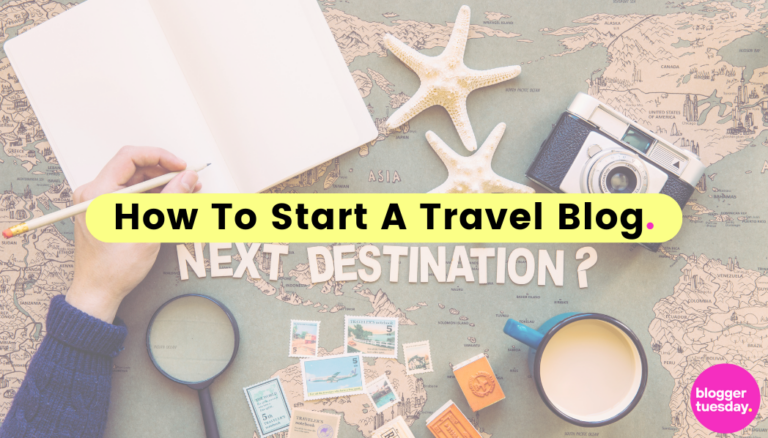Do you love to follow travel blogs? If so, chances are you’ve considered writing one yourself. Reading about other people’s adventures is fascinating. But writing about your own is even better. If you love exploring the world, why not give it a go?
Writing a travel blog is certainly appealing if you have an insatiable wanderlust. But taking the plunge and starting your own travel blog can seem pretty intimidating. You may be worried because you’ve no blogging experience. Maybe you’re not tech-savvy. Don’t worry! Even if you don’t know the difference between a domain name and a meta description, travel blogging is still an option.
There are so many really good reasons to start a travel blog. You could get opportunities to travel for free. You could earn money from your blog. You may bag some freebies along the way. You’ll certainly have a permanent record of all your travel adventures to treasure. But how can you make all this a reality? Read on to discover how to start a travel blog and let your adventure begin:
Research, Research, and Research Some More
You’re probably desperate to get blogging. First, it’s time for some research. There’s no doubt this is an exciting project. But preparation is essential. There’s huge numbers of travel blogs out there. So, it’s a crowded space. But that doesn’t mean you shouldn’t start a travel blog. You just need to understand how to do it really well.
Checking out other travel blogs is vital. Take a look at the ones that rank high on search. See which travel blogs have huge social media followings. What makes these blogs different? Examine them to see why they’re so popular.
Pick Your Niche
When you’re trying to figure out how to start a blog, you need to begin with your why. Before you learn any more about blogging, think about your reason. Knowing why you’re doing this and what you want from it is essential.
Think about whether your blog will have a theme. Will it focus on solo travel? How about a blog about travelling as a family? Or maybe your content will be about adventure travel. Finding a niche makes it simpler to promote your blog. You’ll then have a better understanding of who the blog will appeal to. This helps you tailor your content to match your audience. It also helps your blog to stand out. This is especially crucial if you plan to monetise your blog. It’s less important if your blog’s simply a hobby.
Select the Perfect Blog Name
Now you’ve got your niche, you need a blog name. Choosing a name is so crucial when you’re learning how to start a travel blog. Your blog name creates that all-important first impression. So, you need to make it count.
Here are some things to keep in mind when choosing a blog name:
- Is the name memorable?
- Does it match the content of your travel blog?
- Have you checked that it’s not offensive in other languages?
- Are there other blogs with the same or similar name?
- Will the name appeal to your target audience?
If you’re struggling to choose a name, you could use a name generator. It also pays to check the name you want is available as a domain name. If it’s already taken, you’ll need to think of something new.
Image Pexels CC0 License
Choose a Blogging Platform
Here’s where starting a travel blog gets a little more real. It’s time to choose a blogging platform. You’re going to be working with this a lot. So, it pays to pick the right one.
If you don’t know how to code, don’t worry. Content management systems, such as WordPress, mean you don’t need to be a coding genius. Instead, give yourself time to get familiar with WordPress, and it’ll be super easy to use.
Tonnes of bloggers use WordPress. But if you want to use a different CMS, Wix and Weebly are also popular choices. There’s no right or wrong answer here. Just choose the one that best suits you.
Set up Hosting
The next technical job you need to do is to set up web hosting. Essentially, this is a space you rent or buy to make your blog accessible online. It gives you space on a server for your website, files, and images to be stored. You can choose dedicated hosting which gives you a server to yourself. Alternatively, there’s shared hosting, which tends to cost less. There are quite a few different web hosting services available. But you need to pick well to give your blog the best chance of success. Here are a few things to consider when choosing web hosting:
Speed
Slow-loading pages create a poor user experience (UX). So, it’s wise to pick a web hosting service with fast loading speeds. Choosing dedicated web hosting can help with this.
Security
Cybersecurity is always a major concern. Choose a web hosting service that offers security features, including:
- SSL certificates.
- Regular updates.
- Firewalls.
Downtime
Downtime is bad news for your blog. Again, this creates a bad user experience (UX). Plus, you’ll lose valuable page views when your blog is down. This makes choosing a hosting service with high levels of uptime essential.
Customer Support
When you’re learning how to start a travel blog, chances are you’ll have lots of questions. This makes it important to use a hosting service with excellent customer support. Ideally, choose a hosting service with 24/7 support. This means that you can get help when you’re travelling, no matter where you are.
Hosting plans are available at different prices. So, be sure to compare them to find the right plan for your needs.
Build Your Blogging Brand
Now’s your chance to start getting creative. It’s time to build your blog’s brand. When you first thought about learning how to start a blog, you probably had a vision in mind. Creating your blog’s brand is super exciting.
This starts with choosing a WordPress theme for your blog. From here, you can play around to get it looking perfect. Be sure to align the visual branding with your niche. To create a strong blog brand, your visual content and written content need to work in harmony. So, try to present them both in a cohesive way on your blog.
Image Pexels CC0 License
Create Your Main Pages
Creating your theme and branding is the first step to success. Next, you need to start laying the foundations for your blogging site. This means creating the main pages people will visit on your blog. These include:
- Homepage.
- About me/us page.
- Contact us.
- Landing page for your blog posts.
Think of these pages as the foundation of your blog. Once you’ve got these, you can then start building up the rest of your content.
Write a Content Strategy
Writing content for your blog can seem pretty overwhelming. But you’ve done the hard bit now. This next part is where the fun begins. It’s time to start writing your first travel blog posts.
To stay organised and prevent things getting overwhelming, you need a content strategy. Planning out what you’re going to write about and when you’re going to publish it is a massive help. It also allows you to plan your content around when you’ll be travelling.
Before you start writing your blog posts, you may find it helps to brainstorm some ideas. This is a great way to get your creativity flowing.
Promote Your Blog to Grow Your Audience
Once your blog is up and has some content it’s time to start growing your audience. To do this, it helps to set up social media accounts in the name of your blog. You can then engage with your audience and tease new content.
Don’t forget to set up Google Analytics at this point. This will help you actively track how your posts are performing. This data is so valuable for informing your future content.
Monetise Your Travel Blog
Promoting your travel blog is essential if you want to monetise it. The good news is there are a few ways to make money from your blog.
- Advertising – you could allow ads to be published on your blog. You can get started with this by signing up for Google AdSense.
- Paid posts/sponsored content – brands may choose to work with you by paying you to post content on your blog.
- Freebies/press trips – To help promote their own travel products and destinations, companies may want to work with you. Receiving free products and trips in exchange for a review is a big benefit of travel blogging!
Final Thoughts
You may need to wait until your blog is more established and gets more visitors before you can start monetising it. In the meantime, this is your opportunity to get to grips with the art of travel blogging. Simply stay focused on creating great content and having fun. The rest will all fall into place. So, for now, keep travelling, and keep writing!


